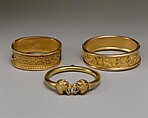Bracelet
Probably Charles F. Mason American
The body of this gold bracelet is constructed of hollow tubes with an internal self-closing hinged spring mechanism. The bracelet terminates in two cast and chased lions' heads with ruby-colored glass cabochon eyes. The bracelet is stamped near the hinge: "PAT NOV. 12 78." This bracelet was most likely made by Charles E. Mason of the Attleboro, Massachusetts jewelry firm Mason, Draper & Co. On May 3, 1881, Mason was awarded a patent for the hinge mechanism used in this bracelet.
The design of the bracelet is adapted from an ancient example in the so-called Curium Treasure (74.51.3559). The original bangle was acquired by General Luigi Palma di Cesnola, U.S. consul to Cyprus, and was purchased by the Met in 1875 along with a substantial portion of Cesnola’s collection of antiquities of Greek, Phoenician, Assyrian, and Egyptian origin. Cesnola became the Metropolitan Museum’s first director in 1879 and served in that position until his death in 1904. He commissioned Tiffany & Co. to create reproductions of the Curium bracelet and several other pieces, which Tiffany exhibited at the Paris Exposition of 1878. In 2018, the Met acquired an example of the Tiffany copy (2018.383). This design was much appreciated by the American public, and many other jewelers, such as C. E. Mason, created their own contemporary versions of this ancient masterpiece.
Due to rights restrictions, this image cannot be enlarged, viewed at full screen, or downloaded.

